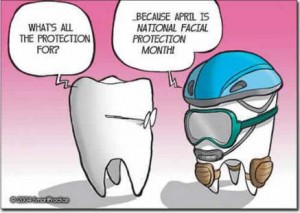April is Facial Protection Month! Don't forget new mouthguards!
April 8th, 2016
 Like you, we are seeing and hearing a lot of promotion for the 2016 Spring Sports season that is about to begin. Registration sign ups for lacrosse, baseball, softball and more are posted all around the Lakes Region. This means we need to do our job to remind our valued patients that proper mouth protection is recommended when you participate in any sports activities. If you wear braces, this protection becomes essential. Injuries to your mouth can not only damage your teeth, but your braces could break and cut open your lip.
Like you, we are seeing and hearing a lot of promotion for the 2016 Spring Sports season that is about to begin. Registration sign ups for lacrosse, baseball, softball and more are posted all around the Lakes Region. This means we need to do our job to remind our valued patients that proper mouth protection is recommended when you participate in any sports activities. If you wear braces, this protection becomes essential. Injuries to your mouth can not only damage your teeth, but your braces could break and cut open your lip.

Mouth Guards
Mouth guards referred to as boil-and-bites can be purchased at many retail stores. As the name implies, these guards are boiled in water to heat and soften the material. While the guard is still warm, you place it in your mouth and bite down gently. This causes the guard to form to the shape of your mouth. Unfortunately, these guards do not necessarily offer the best protection or fit.
The custom fitting of a mouth guard ensures you of better protection and a comfortable fit. Custom guards are also built in layers for durability. The American Dental Association recommends custom guards for orthodontic patients. Your mouth guard will be designed to provide proper protection for both your teeth and your braces.
No matter what type of sport you participate in, a mouth guard can protect your braces. Even an activity as seemingly harmless as table tennis can result in a contact injury. The Academy for Sports Dentistry states that a properly fitted mouth guard should not interfere with any athletic activity.
Custom-fitted mouth protectors are individually designed and made in a dental office or a professional laboratory based on your dentist's instructions. First, your dentist will make an impression of your teeth and a mouth guard is then molded over the model using a special material. Due to the use of the special material and because of the extra time and work involved, this custom-made mouth guard is more expensive than the other types, but it provides the most comfort and best fit and protection.
Who Needs a Mouth Guard?
Mouth guards should be used by anyone -- both children and adults -- who play contact sports such as football, boxing, soccer, ice hockey, basketball, lacrosse, and field hockey. However, even those participating in non-contact sports (for example, gymnastics) and any recreational activity (for example, skateboarding, mountain biking) that might pose a risk of injury to the mouth would benefit from wearing a protective mouth guard.
Adults and children who grind their teeth at night should have a nocturnal bite plate or bite splint made to prevent tooth damage.
Why Use a Mouth Guard When Playing Sports?
Because accidents can happen during any physical activity, the advantage of using a mouth guard is that it can help limit the risk of mouth-related injuries to your lips, tongue, and soft tissues of your mouth. Mouth guards also help you avoid chipped or broken teeth, nerve damage to a tooth or even tooth loss.
Our office will be glad to answer any questions you have so you can continue the activities you enjoy with little concern. If you do suffer any injuries to your mouth or braces during sporting activities, please contact us immediately. The sooner we can care for your mouth, the better the results will be.



